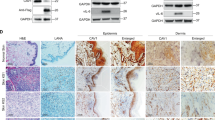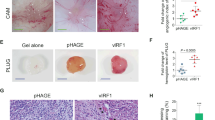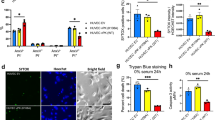Abstract
Kaposi's sarcoma-associated herpesvirus (KSHV) is the cause of Kaposi's sarcoma (KS), which is the most common AIDS-associated malignancy. KS is characterized by neovascularization and spindle cell proliferation. The interaction between HIV-1 and KSHV has a central role in promoting the aggressive manifestations of KS in AIDS patients; however, the pathogenesis underlying AIDS-related KS (AIDS–KS) remains unknown. Herein, we examined the potential of HIV-1 negative factor (Nef) to impact KSHV viral interleukin-6 (vIL-6)-induced angiogenesis and tumorigenesis. In vitro experiments showed that exogenous Nef penetrated vIL-6-expressing endothelial cells. Both internalized and ectopic expression of Nef in endothelial cells and fibroblasts synergized with vIL-6 to promote vascular tube formation and cell proliferation. Using a chicken chorioallantoic membrane (CAM) model, we demonstrated that Nef synergistically promotes vIL-6-induced angiogenesis and tumorigenesis. Animal experiments further showed that Nef facilitates vIL-6-induced angiogenesis and tumor formation in athymic nu/nu mice. Mechanistic studies indicated that Nef synergizes with vIL-6 to enhance angiogenesis and tumorigenesis by activating the AKT pathway in the CAM model, as well as nude mice. LY294002, a specific inhibitor of phosphatidylinositol-3-kinase (PI3K), significantly impaired the ability of Nef to promote vIL-6-induced tumorigenesis in an allograft model of nude mice. Our data provide first-line evidence that Nef may contribute to the pathogenesis underlying AIDS–KS in synergy with vIL-6. These novel findings also suggest that targeting the PI3K/AKT signal may be a potentially effective therapeutic approach in AIDS–KS patients.
This is a preview of subscription content, access via your institution
Access options
Subscribe to this journal
Receive 50 print issues and online access
$259.00 per year
only $5.18 per issue
Buy this article
- Purchase on Springer Link
- Instant access to full article PDF
Prices may be subject to local taxes which are calculated during checkout








Similar content being viewed by others
References
Chang Y, Cesarman E, Pessin MS, Lee F, Culpepper J, Knowles DM et al. Identification of herpesvirus-like DNA sequences in AIDS-associated Kaposi's sarcoma. Science 1994; 266: 1865–1869.
Blum L, Pellet C, Agbalika F, Blanchard G, Morel P, Calvo F et al. Complete remission of AIDS-related Kaposi's sarcoma associated with undetectable human herpesvirus-8 sequences during anti-HIV protease therapy. CAIDS 1997; 11: 1653–1655.
Cesarman E, Chang Y, Moore PS, Said JW, Knowles DM . Kaposi's sarcoma-associated herpesvirus-like DNA sequences in AIDS-related body-cavity-based lymphomas. N Engl J Med 1995; 332: 1186–1191.
Boshoff C, Weiss RA . Epidemiology and pathogenesis of Kaposi's sarcoma-associated herpesvirus. Philos Trans R Soc Lond B Biol Sci. 2001; 356: 517–534.
Strathdee SA, Veugelers PJ, Moore PS . The epidemiology of HIV-associated Kaposi's sarcoma: the unraveling mystery. AIDS 1996; 10 (Suppl A): S51–S57.
Ganem D . KSHV infection and the pathogenesis of Kaposi's sarcoma. Annu Rev Pathol 2006; 1: 273–296.
Mocroft A, Youle M, Phillips AN, Halai R, Easterbrook P, Johnson MA et al. The incidence of AIDS-defining illnesses in 4883 patients with human immunodeficiency virus infection. Royal Free/Chelsea and Westminster Hospitals Collaborative Group. Arch Intern Med 1998; 158: 491–497.
Ensoli B, Buonaguro L, Barillari G, Fiorelli V, Gendelman R, Morgan RA et al. Release, uptake, and effects of extracellular human immunodeficiency virus type 1 Tat protein on cell growth and viral transactivation. J Virol 1993; 67: 277–287.
Ensoli B, Cafaro A . HIV-1 and Kaposi's sarcoma. Eur J Cancer Prev 1996; 5: 410–412.
Harrington W Jr., Sieczkowski L, Sosa C, Chan-a-Sue S, Cai JP, Cabral L et al. Activation of HHV-8 by HIV-1 tat. Lancet 1997; 349: 774–775.
Zeng Y, Zhang X, Huang Z, Cheng L, Yao S, Qin D et al. Intracellular Tat of human immunodeficiency virus type 1 activates lytic cycle replication of Kaposi's sarcoma-associated herpesvirus: role of JAK/STAT signaling. J Virol 2007; 81: 2401–2417.
Guo HG, Pati S, Sadowska M, Charurat M, Reitz M . Tumorigenesis by human herpesvirus 8 vGPCR is accelerated by human immunodeficiency virus type 1 Tat. J Virol 2004; 78: 9336–9342.
Chen X, Cheng L, Jia X, Zeng Y, Yao S, Lv Z et al. Human immunodeficiency virus type 1 Tat accelerates Kaposi sarcoma-associated herpesvirus Kaposin A-mediated tumorigenesis of transformed fibroblasts in vitro as well as in nude and immunocompetent mice. Neoplasia 2009; 11: 1272–1284.
Kestler HW 3rd, Ringler DJ, Mori K, Panicali DL, Sehgal PK, Daniel MD et al. Importance of the nef gene for maintenance of high virus loads and for development of AIDS. Cell 1991; 65: 651–662.
Raymond AD, Campbell-Sims TC, Khan M, Lang M, Huang MB, Bond VC et al. HIV Type 1 Nef is released from infected cells in CD45(+) microvesicles and is present in the plasma of HIV-infected individuals. AIDS Res Hum Retroviruse 2011; 27: 167–178.
Caby MP, Lankar D, Vincendeau-Scherrer C, Raposo G, Bonnerot C . Exosomal-like vesicles are present in human blood plasma. Int Immunol 2005; 17: 879–887.
Guy B, Kieny MP, Riviere Y, Le Peuch C, Dott K, Girard M et al. HIV F/3' orf encodes a phosphorylated GTP-binding protein resembling an oncogene product. Nature 1987; 330: 266–269.
Fujii Y, Otake K, Tashiro M, Adachi A . Soluble Nef antigen of HIV-1 is cytotoxic for human CD4+ T cells. FEBS Lett 1996; 393: 93–96.
Guy B, Riviere Y, Dott K, Regnault A, Kieny MP . Mutational analysis of the HIV nef protein. Virology 1990; 176: 413–425.
Macreadie IG, Fernley R, Castelli LA, Lucantoni A, White J, Azad A . Expression of HIV-1 nef in yeast causes membrane perturbation and release of the myristylated Nef protein. J Biomed Sci 1998; 5: 203–210.
Cullen BR . HIV-1 auxiliary proteins: making connections in a dying cell. Cell 1998; 93: 685–692.
Qiao X, He B, Chiu A, Knowles DM, Chadburn A, Cerutti A . Human immunodeficiency virus 1 Nef suppresses CD40-dependent immunoglobulin class switching in bystander B cells. Nat Immunol 2006; 7: 302–310.
Xu W, Santini PA, Sullivan JS, He B, Shan M, Ball SC et al. HIV-1 evades virus-specific IgG2 and IgA responses by targeting systemic and intestinal B cells via long-range intercellular conduits. Nat Immunol 2009; 10: 1008–1017.
He JC, Husain M, Sunamoto M, D'Agati VD, Klotman ME, Iyengar R et al. Nef stimulates proliferation of glomerular podocytes through activation of Src-dependent Stat3 and MAPK1,2 pathways. J Clin Invest 2004; 114: 643–651.
Husain M, D'Agati VD, He JC, Klotman ME, Klotman PE . HIV-1 Nef induces dedifferentiation of podocytes in vivo: a characteristic feature of HIVAN. AIDS 2005; 19: 1975–1980.
Choi J, Walker J, Boichuk S, Kirkiles-Smith N, Torpey N, Pober JS et al. Human endothelial cells enhance human immunodeficiency virus type 1 replication in CD4+ T cells in a Nef-dependent manner in vitro and in vivo. J Virol 2005; 79: 264–276.
Choi J, Walker J, Talbert-Slagle K, Wright P, Pober JS, Alexander L . Endothelial cells promote human immunodeficiency virus replication in nondividing memory T cells via Nef-, Vpr-, and T-cell receptor-dependent activation of NFAT. J Virol 2005; 79: 11194–11204.
Marecki JC, Cool CD, Parr JE, Beckey VE, Luciw PA, Tarantal AF et al. HIV-1 Nef is associated with complex pulmonary vascular lesions in SHIV-nef-infected macaques. Am J Respir Crit Care Med 2006; 174: 437–445.
Molden J, Chang Y, You Y, Moore PS, Goldsmith MAA . Kaposi's sarcoma-associated herpesvirus-encoded cytokine homolog (vIL-6) activates signaling through the shared gp130 receptor subunit. J Biol Chem 1997; 272: 19625–19631.
Aoki Y, Jaffe ES, Chang Y, Jones K, Teruya-Feldstein J, Moore PS et al. Angiogenesis and hematopoiesis induced by Kaposi's sarcoma-associated herpesvirus-encoded interleukin-6. Blood 1999; 93: 4034–4043.
Aoki Y, Jones KD, Tosato G . Kaposi's sarcoma-associated herpesvirus-encoded interleukin-6. J Hematother Stem Cell Res 2000; 9: 137–145.
Aiken C, Konner J, Landau NR, Lenburg ME, Trono D . Nef induces CD4 endocytosis: requirement for a critical dileucine motif in the membrane-proximal CD4 cytoplasmic domain. Cell 1994; 76: 853–864.
Peter F . HIV nef: the mother of all evil? Immunity 1998; 9: 433–437.
Blagoveshchenskaya AD, Thomas L, Feliciangeli SF, Hung CH, Thomas G . HIV-1 Nef downregulates MHC-I by a PACS-1- and PI3K-regulated ARF6 endocytic pathway. Cell 2002; 111: 853–866.
Greenway AL, Holloway G, McPhee DA, Ellis P, Cornall A, Lidman M . HIV-1 Nef control of cell signalling molecules: multiple strategies to promote virus replication. J Biosci 2003; 28: 323–335.
Mullberg J, Geib T, Jostock T, Hoischen SH, Vollmer P, Voltz N et al. IL-6 receptor independent stimulation of human gp130 by viral IL-6. J Immunol 2000; 164: 4672–4677.
Meads MB, Medveczky PG . Kaposi's sarcoma-associated herpesvirus-encoded viral interleukin-6 is secreted and modified differently than human interleukin-6: evidence for a unique autocrine signaling mechanism. J Biol Chem 2004; 279: 51793–51803.
Kaaya EE, Parravicini C, Ordonez C, Gendelman R, Berti E, Gallo RC et al. Heterogeneity of spindle cells in Kaposi's sarcoma: comparison of cells in lesions and in culture. J Acquir Immune Defic Syndr Hum Retrovirol 1995; 10: 295–305.
Cerimele F, Curreli F, Ely S, Friedman-Kien AE, Cesarman E, Flore O . Kaposi's sarcoma-associated herpesvirus can productively infect primary human keratinocytes and alter their growth properties. J Virol 2001; 75: 2435–2443.
Akula SM, Naranatt PP, Walia NS, Wang FZ, Fegley B, Chandran B . Kaposi's sarcoma-associated herpesvirus (human herpesvirus 8) infection of human fibroblast cells occurs through endocytosis. J Virol 2003; 77: 7978–7990.
Hanna Z, Kay DG, Rebai N, Guimond A, Jothy S, Jolicoeur P . Nef harbors a major determinant of pathogenicity for an AIDS-like disease induced by HIV-1 in transgenic mice. Cell 1998; 95: 163–175.
Delli Bovi P, Donti E, Knowles DM 2nd, Friedman-Kien A, Luciw PA, Dina D et al. Presence of chromosomal abnormalities and lack of AIDS retrovirus DNA sequences in AIDS-associated Kaposi's sarcoma. Cancer Res 1986; 46: 6333–6338.
Zhu X, Zhou F, Qin D, Zeng Y, Lv Z, Yao S et al. Human immunodeficiency virus type 1 induces lytic cycle replication of Kaposi's-sarcoma-associated herpesvirus: role of Ras/c-Raf/MEK1/2, PI3K/AKT, and NF-kappaB signaling pathways. J Mol Biol 2011; 410: 1035–1051.
Mercader M, Taddeo B, Panella JR, Chandran B, Nickoloff BJ, Foreman KE . Induction of HHV-8 lytic cycle replication by inflammatory cytokines produced by HIV-1-infected T cells. Am J Pathol 2000; 156: 1961–1971.
Merat R, Amara A, Lebbe C, de The H, Morel P, Saib A . HIV-1 infection of primary effusion lymphoma cell line triggers Kaposi's sarcoma-associated herpesvirus (KSHV) reactivation. Int J Cancer 2002; 97: 791–795.
Varthakavi V, Browning PJ, Spearman P . Human immunodeficiency virus replication in a primary effusion lymphoma cell line stimulates lytic-phase replication of Kaposi's sarcoma-associated herpesvirus. J Virol 1999; 73: 10329–10338.
Voelkel NF, Cool CD, Flores S . From viral infection to pulmonary arterial hypertension: a role for viral proteins? AIDS 2008; 22 (Suppl 3): S49–S53.
Morris VA, Punjabi AS, Lagunoff M . Activation of Akt through gp130 receptor signaling is required for Kaposi's sarcoma-associated herpesvirus-induced lymphatic reprogramming of endothelial cells. J Virol 2008; 82: 8771–8779.
Morris VA, Punjabi AS, Wells RC, Wittkopp CJ, Vart R, Lagunoff M . The KSHV viral IL-6 homolog is sufficient to induce blood to lymphatic endothelial cell differentiation. Virology 2012; 428: 112–120.
Suthaus J, Adam N, Grotzinger J, Scheller J, Rose-John S . Viral Interleukin-6: structure, pathophysiology and strategies of neutralization. Eur J Cell Biol 2011; 90: 495–504.
Wan X, Wang H, Nicholas J . Human herpesvirus 8 interleukin-6 (vIL-6) signals through gp130 but has structural and receptor-binding properties distinct from those of human IL-6. J Virol 1999; 73: 8268–8278.
Moore PS, Boshoff C, Weiss RA, Chang Y . Molecular mimicry of human cytokine and cytokine response pathway genes by KSHV. Science 1996; 274: 1739–1744.
Beral V, Peterman TA, Berkelman RL, Jaffe HW . Kaposi's sarcoma among persons with AIDS: a sexually transmitted infection? Lancet 1990; 335: 123–128.
Leonard JA, Filzen T, Carter CC, Schaefer M, Collins KL . HIV-1 Nef disrupts intracellular trafficking of major histocompatibility complex class I, CD4, CD8, and CD28 by distinct pathways that share common elements. J Virol 2011; 85: 6867–6881.
Linnemann T, Zheng YH, Mandic R, Peterlin BM . Interaction between Nef and phosphatidylinositol-3-kinase leads to activation of p21-activated kinase and increased production of HIV. Virology 2002; 294: 246–255.
Wolf D, Witte V, Laffert B, Blume K, Stromer E, Trapp S et al. HIV-1 Nef associated PAK and PI3-kinases stimulate Akt-independent Bad-phosphorylation to induce anti-apoptotic signals. Nat Med 2001; 7: 1217–1224.
Zhu TS, Costello MA, Talsma CE, Flack CG, Crowley JG, Hamm LL et al. Endothelial cells create a stem cell niche in glioblastoma by providing NOTCH ligands that nurture self-renewal of cancer stem-like cells. Cancer Res 2011; 71: 6061–6072.
Junkin M, Wong PK . Probing cell migration in confined environments by plasma lithography. Biomaterials 2011; 32: 1848–1855.
Qin D, Feng N, Fan W, Ma X, Yan Q, Lv Z et al. Activation of PI3K/AKT and ERK MAPK signal pathways is required for the induction of lytic cycle replication of Kaposi's sarcoma-associated herpesvirus by herpes simplex virus type 1. BMC Microbiol 2011; 11: 240.
Zhou F, Xue M, Qin D, Zhu X, Wang C, Zhu J et al. HIV-1 Tat Promotes Kaposi's Sarcoma-Associated Herpesvirus (KSHV) vIL-6-induced angiogenesis and tumorigenesis by regulating PI3K/PTEN/AKT/GSK-3beta signaling pathway. PloS One 2013; 8: e53145.
Qin D, Zeng Y, Qian C, Huang Z, Lv Z, Cheng L et al. Induction of lytic cycle replication of Kaposi's sarcoma-associated herpesvirus by herpes simplex virus type 1: involvement of IL-10 and IL-4. Cell Microbiol 2008; 10: 713–728.
Tang Q, Qin D, Lv Z, Zhu X, Ma X, Yan Q et al. Herpes simplex virus type 2 Triggers reactivation of Kaposi's sarcoma-associated herpesvirus from latency and collaborates with HIV-1 Tat. PLoS One 2012; 7: e31652.
Acknowledgements
This work was supported by grants from the National Basic Research Program of China (973 Program) (2011CB504803), National Natural Science Foundation of China (81171552, 30972619, 30900064, 31270199), the Ph.D Programs Foundation of Ministry of Education of China (20123234110006), Natural Science Foundation of Ministry of Education of Jiangsu Province (great project 10KJA310032 and grant 09KJB310007), Research Fund for the Doctoral Program of Higher Education of China (New Teacher Fund, grant 20093234120004) and China Postdoctoral Science Foundation (2012M511304).
Author Contributions: Conceived and designed the experiments: DQ and CL. Performed the experiments: XZ, YG, SY, QY, MX, TH and FZ. Analyzed the data: XZ, JZ, DQ and CL. Wrote the paper: XZ and CL.
Author information
Authors and Affiliations
Corresponding authors
Ethics declarations
Competing interests
The authors declare no conflict of interest.
Additional information
Supplementary Information accompanies this paper on the Oncogene website
Rights and permissions
About this article
Cite this article
Zhu, X., Guo, Y., Yao, S. et al. Synergy between Kaposi's sarcoma-associated herpesvirus (KSHV) vIL-6 and HIV-1 Nef protein in promotion of angiogenesis and oncogenesis: role of the AKT signaling pathway. Oncogene 33, 1986–1996 (2014). https://doi.org/10.1038/onc.2013.136
Received:
Revised:
Accepted:
Published:
Issue Date:
DOI: https://doi.org/10.1038/onc.2013.136
Keywords
This article is cited by
-
An oncogenic viral interferon regulatory factor upregulates CUB domain-containing protein 1 to promote angiogenesis by hijacking transcription factor lymphoid enhancer-binding factor 1 and metastasis suppressor CD82
Cell Death & Differentiation (2020)
-
Viral interleukin-6 encoded by an oncogenic virus promotes angiogenesis and cellular transformation by enhancing STAT3-mediated epigenetic silencing of caveolin 1
Oncogene (2020)
-
A DHX9-lncRNA-MDM2 interaction regulates cell invasion and angiogenesis of cervical cancer
Cell Death & Differentiation (2019)
-
Suppression of the SAP18/HDAC1 complex by targeting TRIM56 and Nanog is essential for oncogenic viral FLICE-inhibitory protein-induced acetylation of p65/RelA, NF-κB activation, and promotion of cell invasion and angiogenesis
Cell Death & Differentiation (2019)
-
Cellular and viral oncogenes: the key to unlocking unknowns of Kaposi’s sarcoma-associated herpesvirus pathogenesis
Archives of Virology (2018)



